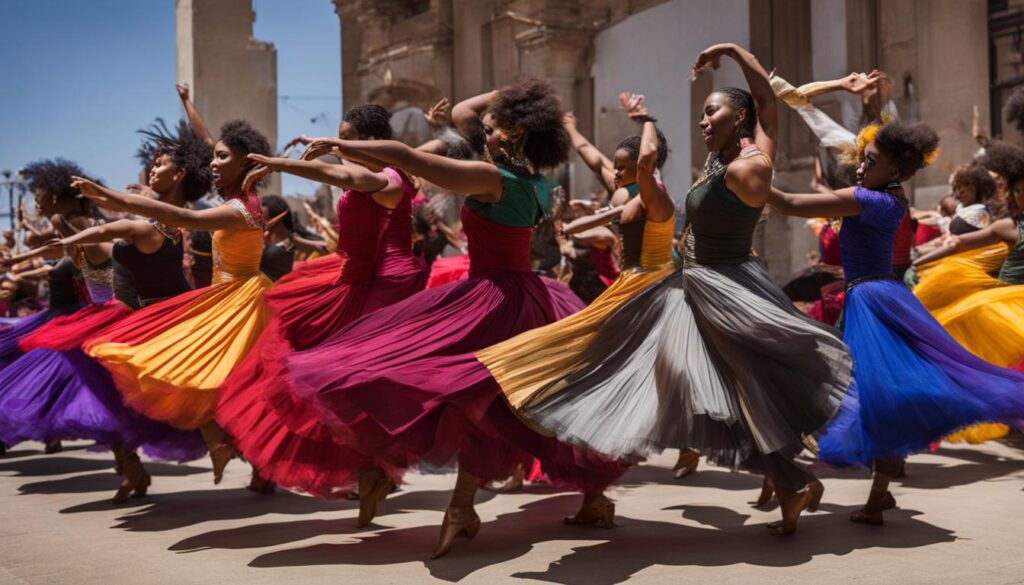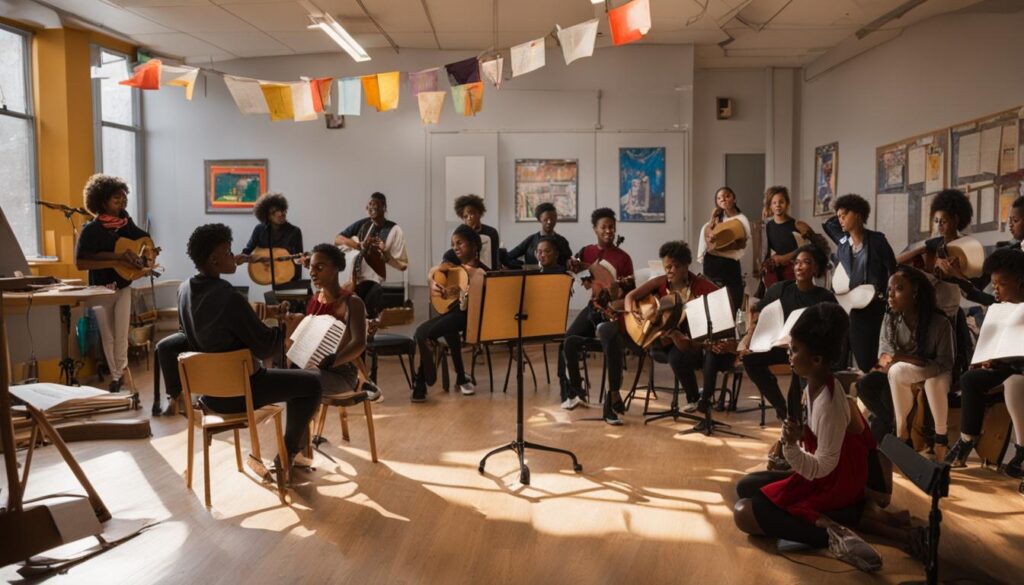Visual and performing arts play a crucial role in our lives, offering countless benefits and making a significant impact on society, education, and personal development. From expressing emotions to preserving history, art is a universal language that enriches our world.
Key Takeaways:
- Visual and performing arts provide numerous benefits and impact society, education, and personal growth.
- Art serves as a universal language, preserving history and creating cultural understanding.
- Visual arts education nurtures creativity and critical thinking in students.
- Performing arts education fosters self-discovery, collaboration, and personal development.
- Embracing and supporting the importance of visual and performing arts creates a more vibrant world.
The Role of Art in Society: Preserving History and Creating Cultural Understanding
Art, both visual and performing, plays a crucial role in society as it serves as a universal language that goes beyond words and numbers. It has the power to express ideas, emotions, and stories in a way that resonates with people from different cultures and backgrounds. Through art, we can preserve history, capture significant moments, and document the diverse cultures that make up our society.
Art is not only a means of expressing individual creativity, but it also promotes cultural understanding and collaboration within communities. It brings people together, fostering a sense of unity and shared vision for the future. By appreciating and engaging with art, we gain insights into different perspectives and develop empathy towards others. Art encourages us to celebrate diversity and embrace the richness of various cultures.
Visual arts, in particular, have a unique ability to stimulate thinking and transform visual content, creating an enriched and inspiring environment. They challenge our perceptions, provoke thought, and encourage us to see the world from new perspectives. Visual arts provide a platform for dialogue and reflection, allowing us to explore complex social issues and generate meaningful conversations.
Art enables us to communicate across language barriers and connect with one another on a profound level. It allows us to express our deepest emotions, celebrate our shared humanity, and challenge societal norms. Through art, we can preserve our collective history, create cultural understanding, and inspire positive change in our society.
Table: The Impact of Visual and Performing Arts in Society
| Significance | Impact | Value |
|---|---|---|
| Preserving history | Capturing significant moments and documenting cultures | Ensuring our shared heritage is not forgotten |
| Cultural understanding | Promoting empathy, unity, and celebration of diversity | Fostering collaboration and shared visions for the future |
| Stimulating thinking | Transforming visual content and challenging perceptions | Creating an enriched and inspiring environment |
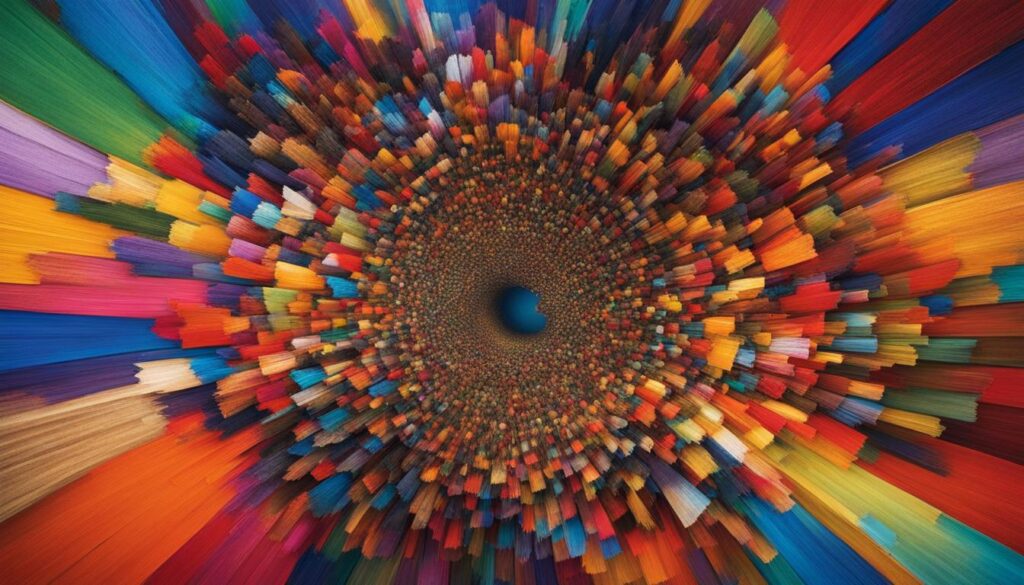

Art has the power to shape our society and create lasting change. It is a vital force that preserves our history, fosters cultural understanding, and inspires a more inclusive and harmonious world. By recognizing the value of visual and performing arts, we can appreciate their impact and support their continued growth and development.
The Importance of Visual Arts in Education: Nurturing Creativity and Critical Thinking
Visual arts education plays a crucial role in nurturing the creativity and critical thinking skills of students. These skills are essential for their overall development and future success. By engaging in visual arts activities, students are encouraged to think outside the box, explore their imaginations, and express their ideas in unique and creative ways.
One of the significant effects of visual arts education is its positive impact on students’ academic performance. Studies have shown that students who participate in visual arts classes tend to excel in other subjects as well. This is because visual arts stimulate critical thinking skills, problem-solving abilities, and cognitive development. Engaging in art activities allows students to observe, analyze, and interpret the world around them, enhancing their ability to think critically and make connections between different concepts.
Moreover, visual arts education provides students with a platform for self-expression and personal development. It allows them to communicate their thoughts and emotions visually, fostering a sense of self-confidence and self-awareness. Through art, students can explore their identity, values, and beliefs, gaining a deeper understanding of themselves and the world. Art also encourages students to take risks and embrace mistakes as part of the creative process, promoting resilience and adaptability.
Table: Benefits of Visual Arts Education
| Benefits | Description |
|---|---|
| Enhanced creativity | Visual arts education allows students to tap into their creative potential, leading to innovative thinking and problem-solving skills. |
| Improved academic performance | Engaging in visual arts classes has been linked to improved performance in other academic subjects, such as language arts and mathematics. |
| Enhanced critical thinking | Visual arts stimulate critical thinking skills, enabling students to analyze, interpret, and make connections between different concepts. |
| Promotion of self-expression | Through art, students can express their thoughts, emotions, and ideas visually, promoting self-confidence and self-awareness. |
| Development of problem-solving skills | Visual arts activities require students to think creatively and find innovative solutions to artistic challenges, developing their problem-solving abilities. |
Despite these clear benefits, visual arts education often faces challenges and threats to its inclusion in the curriculum. Budget cuts and a focus on standardized testing have led to a decrease in arts programs in schools. However, it is essential to recognize the significance of visual arts in education and advocate for its continued support. By doing so, we can ensure that students have access to the transformative power of visual arts and the numerous benefits it brings to their lives.
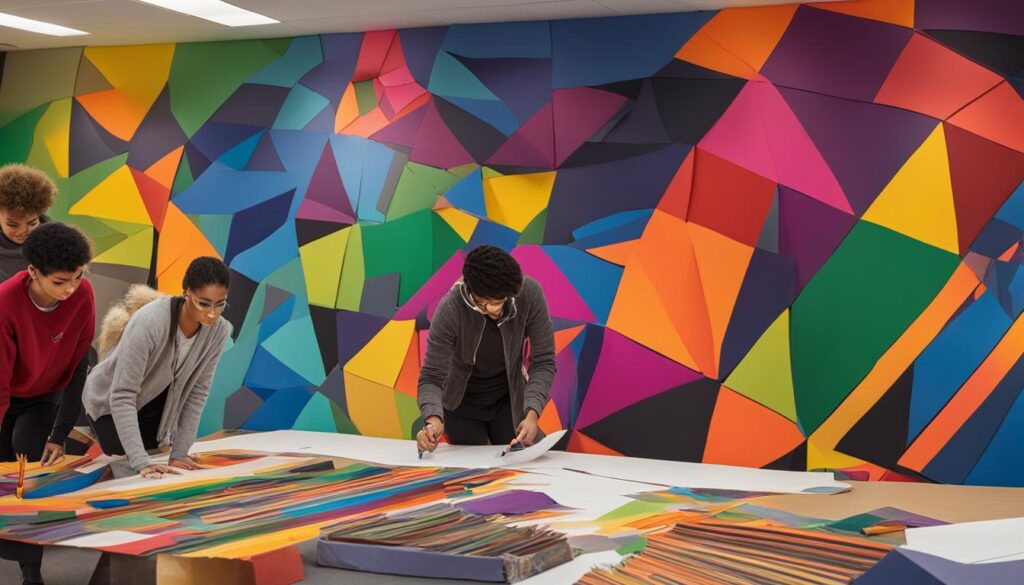

“Art enables us to find ourselves and lose ourselves at the same time.” – Thomas Merton
The Benefits of Performing Arts Education: Self-Discovery and Collaboration
Performing arts education offers a wide range of benefits for students, promoting self-discovery and fostering collaboration. Through music, dance, and drama, students have the opportunity to explore their emotions, develop their unique voice, and gain confidence. Engaging in performing arts activities allows children to express themselves creatively, leading to improved academic performance and enhanced communication skills.
One of the key advantages of performing arts education is the emphasis on self-discovery. The performing arts provide a platform for students to explore their identities and understand the world around them. By participating in various artistic disciplines, students are encouraged to tap into their emotions, thoughts, and experiences, developing a deeper understanding of themselves and their place in society.
Collaboration is another essential skill nurtured through performing arts education. Whether it’s working together on a musical production, coordinating dance routines, or preparing for a theatrical performance, students learn the value of teamwork. Every role, big or small, contributes to the overall success of a production, teaching the importance of cooperation and collective effort. These collaborative experiences not only enhance social skills but also instill important life skills such as problem-solving, adaptability, and effective communication.
The Power of Performing Arts
“Performing arts education allows students to discover their true potential, fostering their creativity and providing a platform for self-expression. It encourages them to step outside their comfort zones, take risks, and embrace new challenges. The performing arts empower students to communicate their ideas, thoughts, and emotions in unique and impactful ways, making it an invaluable part of their education journey.
By actively participating in performing arts education, students gain valuable life skills that extend beyond the stage. The self-discipline required to master a musical instrument, the focus needed to perfect dance movements, and the determination to deliver a powerful theatrical performance all contribute to personal growth and development. Students also learn to appreciate diverse forms of artistic expression, broadening their perspectives and cultivating a deeper appreciation for the arts.
| Benefits of Performing Arts Education | Relevance of Performing Arts |
|---|---|
| Enhanced self-expression and creativity | Developing critical thinking and problem-solving skills |
| Improved communication and collaboration | Fostering social and emotional development |
| Boosted self-confidence and self-esteem | Contributing to overall academic success |
As society continues to evolve, the significance of performing arts education remains steadfast. It equips students with the skills and qualities necessary to thrive in a rapidly changing world. The benefits of performing arts education extend far beyond the classroom, empowering students to embrace their creativity, work collaboratively, and express themselves authentically.
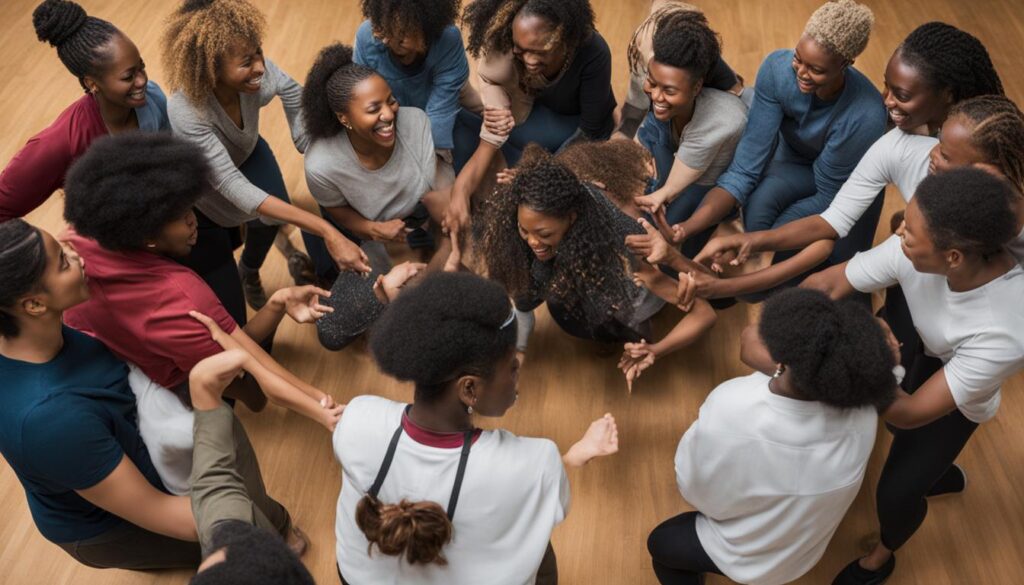

Engaging in performing arts education allows students to discover their true potential, fostering their creativity and providing a platform for self-expression. It encourages them to step outside their comfort zones, take risks, and embrace new challenges. The performing arts empower students to communicate their ideas, thoughts, and emotions in unique and impactful ways, making it an invaluable part of their education journey.
The Importance of Visual and Performing Arts: Enriching Society, Education, and Personal Growth
Visual and performing arts play a vital role in our lives, offering numerous benefits and making a significant impact on society, education, and personal development. Their importance cannot be overstated, as they provide a means of expression, preserve history, foster cultural understanding, and nurture creativity and critical thinking skills.
Art, both visual and performing, holds great significance in society. It serves as a universal language that transcends words and numbers, allowing us to convey ideas, emotions, and stories in unique and powerful ways. It plays a crucial role in preserving history, capturing important moments, and documenting diverse cultures. Additionally, art promotes cultural understanding and collaboration among communities, bringing people together and fostering shared visions for the future.
In the realm of education, visual arts are often overlooked but are essential for the holistic growth of children. Engaging in the visual arts enhances students’ ability to think creatively and critically, thereby improving their performance in other academic areas. Through art classes, students have the opportunity to express independent thought, explore their creative potential, and develop critical thinking skills and self-confidence. Art education has been proven to enhance academic achievement and sharpen processing, problem-solving, and communication abilities.
Similarly, performing arts education offers numerous benefits to students. It allows them to embark on a journey of self-discovery, exploring their emotions, finding their unique voice, and gaining confidence. Engaging in music, dance, and drama helps students engage their whole being, leading to improved academic performance and enhanced communication skills. Furthermore, performing arts teach the importance of collaboration and teamwork, showing students that every role, no matter how small, contributes to the overall success of a production. By participating in performing arts, students learn valuable life skills such as self-expression, communication, creativity, and critical thinking, all of which are applicable to various aspects of their lives.
In conclusion, visual and performing arts hold immense value in our society, education, and personal growth. They provide a platform for self-expression, a vehicle for preserving history, a tool for cultural understanding, and a catalyst for creativity and critical thinking. Recognizing and supporting the importance of visual and performing arts is crucial for creating a more vibrant and enriched world for ourselves and future generations.
FAQ
Why is visual and performing arts important?
Visual and performing arts are important because they serve as a universal language that helps express ideas, emotions, and stories that words and numbers alone cannot convey. They also play a significant role in preserving history, capturing moments, and documenting cultures, promoting cultural understanding and collaboration among diverse communities.
What is the role of art in society?
The role of art in society is to preserve history, create cultural understanding, and promote collaboration among diverse communities. It serves as a means of expression and a way to bring people together, fostering the creation of shared visions for the future. The visual arts stimulate thinking and transform the visual content, creating a more enriching and inspiring environment.
Why is visual arts education important?
Visual arts education is important because it enhances students’ ability to think creatively and critically, improving their performance in other academic areas. It provides a unique opportunity for independent thought and creative freedom, developing critical thinking skills and confidence in students. Art education has been shown to improve academic achievement and enhances the processing, problem-solving, and communication abilities of children.
What are the benefits of performing arts education?
Performing arts education offers numerous benefits to students. It fosters self-discovery and personal development, allowing children to explore their emotions, develop their unique voice, and gain confidence. Through music, dance, and drama, students engage their brain, body, and emotions, leading to improved academic performance and enhanced communication skills. Performing arts also teach the importance of collaboration and teamwork, as every role, big or small, contributes to the overall success of a production.
Why should visual and performing arts be recognized and supported?
Visual and performing arts hold immense value in our society, education, and personal development. They provide a means of expression, preserve history, create cultural understanding, and nurture creativity and critical thinking skills. By embracing and fostering the importance of visual and performing arts, we can create a more vibrant and enriched world for ourselves and future generations.
